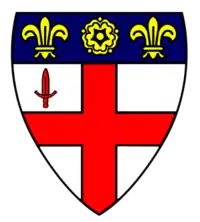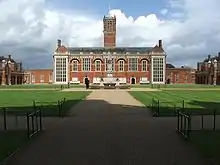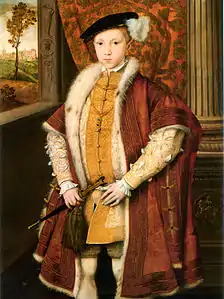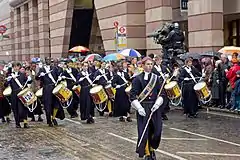Christ's Hospital
Christ's Hospital, also known colloquially as CH, is an English coeducational independent day and boarding school with Royal Charter located to the south of Horsham in West Sussex. Founded in 1552 and receiving its first Royal Charter in 1553, Christ's Hospital follows the public schools tradition. Since its establishment, Christ's Hospital has been a charity school, with a core aim to offer children from humble backgrounds the chance of a better education.
| Christ's Hospital | |
|---|---|
 | |
| Location | |

| |
| , West Sussex , RH13 0YP United Kingdom | |
| Coordinates | 51°02′39″N 0°21′47″W |
| Information | |
| Type | Public school Independent boarding school |
| Religious affiliation(s) | Church of England |
| Established | 1552 |
| Founder | King Edward VI |
| Department for Education URN | 126107 Tables |
| President | The Duke of Gloucester |
| Chairman of the Council | Christopher Steane[1] |
| Head Teacher | Simon Reid[2] |
| Deputy Heads | Ruth Brading and Luke Walters[2] |
| Gender | Co-educational |
| Age | 11 to 18 |
| Enrollment | 900 (2017)[3] |
| Houses | Peele, Thornton, Middleton, Coleridge, Lamb, Barnes, Maine, Leigh Hunt |
| Colour(s) | Blue & Yellow |
| Publication | Housey! The Blue The Broadie |
| Patron | Queen Elizabeth II |
| Former pupils | Old Blues |
| School Song | Votum The Foundation Hymn The Hertford Grace |
| Website | http://www.christs-hospital.org.uk/ |
Charitable foundation

Christ's Hospital is almost unique for a British independent school in that the majority of the students receive bursaries. This stems from its founding charter as a charitable school. School fees are paid on a means-tested basis, with substantial subsidies paid by the school or their benefactors, so that pupils from all walks of life are able to have private education that would otherwise be beyond the means of their parents.

The trustees of the foundation are the Council of Almoners, chaired by the Treasurer of Christ's Hospital, who govern the foundation according to a Scheme of Administration granted by the Charity Commission. The historic Court of Governors survives as a formal institution consisting of over 650 benefactors but its powers have since the 19th century been largely transferred to the smaller Council of Almoners.
In 2007 Christ's Hospital was formally separated into two related registered charities: Christ's Hospital Foundation[4] and Christ's Hospital School.[5]
History


Christ's Hospital was the result of the foundation by Henry VIII and confirmed by King Edward VI, assisted by Nicholas Ridley, Bishop of London, and Sir Richard Dobbs, Lord Mayor of London.[6] Its genesis was the earlier Dissolution of the Monasteries and the resultant overflow onto the streets of the poor and destitute. Encouraged by a sermon from Ridley, exhorting mercy to the poor, the King wrote to the Lord Mayor encouraging him to action. This he did via a committee of 30 merchants. Henry VIII had already granted the use of Greyfriars to the City for the relief of the poor and to house the homeless children which the magistrates had taken notice of.[7] Edward granted Bridewell Palace, his lands at the Savoy, and rents and other chattels to create three Royal Hospitals — Bridewell Hospital (now the King Edward's School, Witley, Surrey), St Thomas' Hospital and Christ's Hospital, which was for the education of poor children.
The first boys and girls entered the school in Newgate in 1552. The Royal Charter was granted and signed by its founder, Edward VI, the following year. The first treasurer was Richard Grafton. The Protestant foundation survived the Marian period and in the 1560s it sent its first scholars to Oxford and Cambridge.
The school occupied Newgate as its major site for 350 years, but from time to time children were housed in other parts of the country. 32 children perished during the Great Plague of 1665. In the following year the Great Fire of London destroyed much of the Hospital, except four cloisters and three wards, but there were no casualties among the children. Around 200 pupils were sent to Islington and Clerkenwell and then to Ware and Hertford.
By the end of the 17th century the buildings had been rebuilt with the assistance of Sir Christopher Wren, a governor of Christ's Hospital, and Nicholas Hawksmoor, who designed the Writing School (1696). The church of Christ Church, Newgate Street, designed by Wren, replaced the damaged choir of the former Greyfriars' church and served as a place of worship for the children of Christ's Hospital in the City until the move to Horsham. Through the will of the royal jeweller, George Heriot, it also became the inspiration for the foundation of George Heriot's Hospital in Edinburgh, which was the first of the "Hospital Schools" to be founded in Scotland.
Christ's Hospital was given its second royal charter by Charles II in 1673. This specifically created the Royal Mathematical School, the original purpose of which was to train mathematicians and navigators who would serve as naval officers and merchant seafarers. Samuel Pepys, Secretary to His Majesty's Navy and from 1699 Vice-President of Christ's Hospital, made a considerable contribution to Christ's Hospital. Isaac Newton, Jonas Moore, John Flamsteed, and Edmund Halley contributed to plans for the course of study of the new school within the foundation.

The girls of the hospital settled at Hertford from 1707. The governors had been paying a teacher in Hertford from 1653, and the removal of some children from London following the Great Fire strengthened the link with the town. In 1761, 200 boys under the age of ten along with the boys from Ware were relocated to Hertford. In 1778 the last girls were moved out of London to join the others at Hertford, where the school was rebuilt 1795–1798 to provide accommodation for the new numbers.
Christ's Hospital's most famous upper master was James Boyer who presided from 1778 to 1799 and instructed James Leigh Hunt, Charles Lamb, and Samuel Taylor Coleridge.
In November 1815 the “most infamous Regency flagellant”, an MP named Sir Eyre Coote, entered Christ's Hospital mathematical school, sent away the younger boys and paid the older ones for a session of mutual flogging. The school nurse arrived to find him buttoning his breeches; England's satirical press had come of age in time to make the very most of such a moment. Coote endured a cartoon[8] by George Cruikshank, a vaunted caricaturist, and national humiliation.[9]
Two of the 19th-century London's most notable architects, John Shaw Senior and John Shaw Junior, were architects and surveyors to Christ's Hospital throughout the first half of the 1800s. The Shaws' work included the old school hall (c.1825).
The Duke of Cambridge started a tradition of Royal Presidents in 1854.
A commission of inquiry in 1837 proposed reforms, and in 1864 the Taunton Commission investigated the endowed schools. As a result of this a greater number of girls were admitted. However, in the 1890s boys still outnumbered girls at Hertford.
Another commission in 1877 proposed a new site for the school, where all the boys would be taught. This proposal was questioned by some of the Governors. The Duke of Cambridge said "I am one of those who are perfectly prepared to go with the spirit of the age in which we live, but I confess that I am also one of those who do not love change for change’s sake. To upset an old and long standing institution... is a very dangerous experiment to try."
However, the proposal was carried out. 1,200 acres (4.9 km2) of land outside Horsham in Sussex was purchased from the Aylesbury Dairy Company for £47,500. The foundation stone was laid by Edward, Prince of Wales on 23 October 1897, on behalf of the Sovereign, the date being the anniversary of the birthday of the founder. Architectural features from the old school buildings (the Grecians' Arch and the Wren Arch) were salvaged and incorporated in the new buildings.
The boys were relocated from Newgate and Hertford to the new site in 1902. Hertford became a girls-only school.
Over the centuries Christ's Hospital has continued to enjoy royal patronage. In 1919, George V became the first Royal Patron, followed by George VI in 1937 and HM The Queen in 1953.
Traditions

Links with the City and the Lord Mayor of London are well maintained, with an annual parade through the City of London on St. Matthew's Day and a regular place in the Lord Mayor's Show.
One of the Christ's Hospital traditions is marching into lunch with the band, which is done each day except Sunday, weather permitting.
Another is the annual speech-day parade, where the Lord Mayor of London and his procession watch the school perform a march-past through the main quad. They also join the school in chapel for a grand service, and eat lunch with the Grecian year and their parents. Lastly they move to Big School to hear the Senior Grecian's oration and witness the Grecian prize-giving. This is held on the Saturday at the start of the Summer Half Term.
Uniform
The school's Tudor uniform consists of belted, long blue coats, knee-breeches, yellow socks, and bands at the neck. The uniform has been in place since 1553.[10] The nickname "Blue-coat School" comes from the blue coats worn by the students; however, the nickname used within the school community itself is "Housey" and the long coat is called a "Housey coat".[11]
Second and third form pupils wear a simple leather belt with a buckle. When pupils reach their "Little Erasmus" year (year 9), they are presented with more elaborate hallmarked sterling silver 'broadie' buckles and belts, which the pupils keep after leaving the school.[12]
A complementary uniform was introduced for girls on re-unification of the schools in 1985. This consists of a knee-length pleated skirt, summer jacket, yellow socks (for the boys and junior girls), and grey socks or grey/black tights for senior girls, as well as the long coat in winter, and the bands.
In 2011 students and alumni stated that they saw the uniform as an important way of giving the school a unique identity and unifying the school. Around that time the administrators had discussed the idea of updating the uniform. Over 95% of students voted in favour of keeping the original uniform.[13]
Admissions
As a guide, children entering Christ's Hospital at age 11 into Year 7 need to show evidence of academic potential, working towards the higher end of the ability range in both the Mathematics and English National Curriculum syllabuses.
The assessment process for a bursary place is in two stages. An initial assessment in October which is followed by a residential assessment in January.
Admission in Year 9 is also based on Christ's Hospitals own assessment process. Candidates for entry at age 13 into Year 9 who do not require a bursary may choose to apply to be tested at age 11 and have their place deferred.
All applicants at Year 12 should be on course to achieve a minimum of 4 A (level 7 grades) and 4 B (level 6 grades) at GCSE. Following our an assessment process, offers are made which are conditional on achieved performance at GCSE.
In all cases reports will be requested from a candidate’s current head teacher.
Historic Methods of Entry
Christ’s Hospital has a number of historic methods of entry that are attached to bursary applications.
Wests’ Gift for Children
John and Frances West lived in the latter part of the 17th and early part of the 18th centuries. John became a wealthy merchant in the City of London and lived in a house on the site that is now occupied by the Mansion House.
John and Frances had no children of their own but they did have strong family connections with Newbury, Reading, Twickenham and the City of London. Children from these areas are therefore encouraged to apply for a place at Christ’s Hospital via the West Gift Bursary fund.
RAF Foundationers Trust and 617 Squadron
Sir Barnes Wallis, a former pupil, governor and treasurer set up the RAF Foundationers Trust in 1951. An award was made to him in recognition of his work by the 617 Squadron of the RAF and Wallis set up the fund with the award. The RAF Benevolent Fund donated a like amount.
The fund provides an income for the education of a small number of children in the school at any one time. Consideration for places is given to children of personnel who are serving or who have served in the RAF.
Royal Navy/Royal Mathematical School
Samuel Pepys was a governor and Vice President of the school; he instigated the opening of the Royal Mathematical School at Christ’s Hospital in 1673 which was founded to educate children in mathematics for the practice of navigation. As a result, special consideration for a maximum of forty places is given to children of personnel who are serving, or have served in the Royal Navy, Royal Marines or Royal Navy Reserve.
City Livery Companies
Christ’s Hospital was founded in the City of London over 460 years ago as a charity funded by city businesses and the church to provide training/education to poor street children. The school retains its connections with these organisations, some of which have an ancient right to ‘Present’ a child to the school.
The school Admissions Office is able to advise whether any Presentations are available for a child’s year of entry.
External inspection
In late November 2018, Christ's Hospital underwent a whole school inspection carried out by the Independent Schools Inspectorate. The school met all standards without any action points given.
School activities
Music
Christ's Hospital has a long and distinguished musical tradition and has one of the largest school music departments in the country, with around 35 visiting staff and 9 full-time staff. Famous alumni of Christ's Hospital Music School include conductors Sir Colin Davis, Charles Hazlewood, Adrian Bawtree, and Simon Joly, trumpeter David Mason (formerly Principal Trumpet of the Royal Philharmonic Orchestra), composer Tim Benjamin, and composer and conductor Constant Lambert.
The school's chapel has a large five-manual Rushworth and Dreaper organ, one of four organs in the School (the others being a 3-manual 1829 Hill in Big School, played on by Mendelssohn and Karg-Elert, a 2-manual Father Willis in the Dining Hall, and a Flight and Robson chamber organ in the Court Room). The near 150-strong Chapel Choir has made many recordings and through these has earned an excellent reputation.
Throughout the school's history, many pupils have gone on to take up choral and organ scholarships at Oxford and Cambridge universities or have gained places at leading music conservatories. The school has a symphony orchestra, a chapel choir and many other smaller instrumental ensembles and choirs, along with an annual House Singing Competition. The Music Department organises a public concert every February at St John's, Smith Square in London. The school is also famous as the first place in England to host a complete cycle of the chamber music of Brahms, under the direction of the then Head of Piano John Thwaites.
Christ's Hospital was featured in the first series of the reality television programme Rock School, in which Gene Simmons of KISS helped a group of pupils form their own rock band.[14]

The school's most famous ensemble is its marching band, simply named Christ's Hospital Band. It plays for the daily parade and performs in the annual Lord Mayor's Show in the City of London. The band also has a regular engagement each summer at Lord's Cricket Ground. The band led the procession at the Queen's 80th birthday parade in London on 21 April 2006 and has played at Twickenham Stadium on a number of occasions.
Drama
An Arts Centre complex designed by architect Bill Howell was opened in 1974, including a theatre with Tudor-style auditorium, an extension to the music school, the 'Octagon' rehearsal/performance space, and classrooms.
The Christ's Hospital Arts Centre served as a principal arts venue for Horsham and the surrounding area until the establishment of an arts centre in Horsham in the 1980s. A programme of performances continues to be open to the public.
Former pupils in theatre and film include Jason Flemyng, Leo Gregory,[15] James D'Arcy, Michael Wilding and Roger Allam.
Names of year groups
Each year group has a particular name, unique to Christ's Hospital. The standard English "Year + number" format is not used.
- Second Form (Year 7)
- Third Form (Year 8)
- Little Erasmus ("LE") (Year 9)
- Upper Fourth ("UF") (Year 10)
- Greater Erasmus ("GE") (Year 11)
- Deputy Grecians ("Deps") (Year 12)
- Grecians (Year 13)
Houses

Christ's Hospital has introduced a small number of day students since 2011; however, most of the students continue to be boarders. The school houses are named after notable Old Blues (the CH-specific term for alumni), primarily writers. Each house has an "A" and "B" side, home to roughly 45 pupils. The houses are arranged from west to east as follows:
Avenue houses
- Peele – George Peele (boys)
- Thornton – Edward Thornton[16] (girls)
- Middleton – Thomas Middleton (boys)
- Coleridge – Samuel Taylor Coleridge (girls)
- Lamb – Charles Lamb (boys)
- Barnes – Thomas Barnes (girls)
- Maine – Henry James Sumner Maine (boys)
- Leigh Hunt – Leigh Hunt (girls)
The sixteen original main boarding houses stretch from Peele to Leigh Hunt along The Avenue, built as four H-blocks on either side of the main Quad. Leigh Hunt was originally the pair of preparatory houses, Prep A and Prep B, and were converted to junior houses on the abolition in 1964 of entry at the age of nine.
The sixteen original houses provided two dormitories (Upper Dorm and Lower Dorm) sleeping up to about 30 boys each. As the merger of the boys and girls approached, some dormitories were divided into cubicles, and subsequent developments created dormitories accommodating about twelve pupils each. Since 2001 there has been a rolling refurbishment programme, with the refurbished houses providing a range of accommodation: four-bed rooms for the junior pupils to one-bed rooms for the more senior pupils.
Until 1964, boys at Horsham lived in all-through houses from 2nd Form to Grecians (with the exception of Prep A and Prep B). Then houses were divided into senior houses (Peele, Thornton, Middleton, Coleridge and Lamb) and Junior houses (Barnes, Maine, Leigh Hunt) with boys transferring to a senior house after Little Erasmus. In conjunction with the merger, a further reorganisation occurred with each house converting to a senior side and a junior side. This system reverted to the all-through houses in 2000, now from 2nd Form to Deps.
Grecians houses
Year 13 (Grecian) students move to Grecians houses, which provide a transitional style of life in preparation for university or life beyond school. The two Grecians houses were completed early in 2001, and have individual study bedrooms plus several general common rooms and kitchenettes shared by a group of seven to ten pupils, thus introducing pupils to life in a mixed communal environment as they prepare themselves for university.
- Grecians West (for pupils who were previously in Peele, Thornton, Middleton, and Coleridge)
- Grecians East (for pupils who were previously in Lamb, Barnes, Maine, and Leigh Hunt)
Controversies
Alumni
People educated at Christ's Hospital are called Old Blues.
Staff
Notable members of staff have included:
- Edward Baldwin, 4th Earl Baldwin of Bewdley
- Adrian Bawtree
- Edward Buck
- Samuel Cobb
- Gerald Davies
- Ralph Henry Carless Davis
- John Flamsteed (Astronomer Royal)
- William Hamilton Fyfe
- Bruce Grindlay
- George Andrew Jacob
- Craig Sellar Lang
- Derrick Somerset Macnutt[21]
- William Wales (astronomer)
- Henry Robinson D. D., a 19th-century master[22]
See also
References
- "Our Governance". Christ's Hospital. Retrieved 13 September 2018.
- "Teaching Staff". Christ's Hospital. Retrieved 13 September 2018.
- "CH AT A GLANCE | Christ's Hospital". Christs-hospital.org.uk. Retrieved 13 September 2018.
- Charity Commission. CHRIST'S HOSPITAL FOUNDATION, registered charity no. 306975.
- Charity Commission. CHRIST'S HOSPITAL SCHOOL, registered charity no. 1120090.
- Thornbury, Walter. "Christ's Hospital." Old and New London: Volume 2. London: Cassell, Petter & Galpin, 1878. 364-380 British History Online. Retrieved 18 June 2019.
- Nichols, John Gough. (1851). Chronicle of the Grey Friars of London. London: Printed for the Camden Society by J.B. Nichols and Son, Printers. 'Preface' xxvi-xxvii. The Internet Archive website Retrieved 18 June 2019.
- "A peep into the blue coat school !!!!!!!!!!!-". British Museum. Retrieved 2 June 2019.
- "Sex, drugs and the birth of modernity". The Economist. 23 May 2019. ISSN 0013-0613. Retrieved 2 June 2019.
- Stow, John (1598). Thoms, William J. (ed.). A Survey of London, written in the year 1598 by John Stow (New edition, 1842 ed.). Whittaker. p. 119.
- "London Metropolitan Archives : Information Leaflet Number 29 : Records of Christ's Hospital and Bluecoats Schools" (PDF). Cityoflondon.gov.uk. Retrieved 25 January 2016.
- "Wearing it with Pride". Independent School Parents.
- "Students Vote to Keep Tudor Uniform." British Heritage 32, no. 2 (May 2011): 10. Academic Search Complete, EBSCOhost (accessed 27 August 2011).
- Archived 17 October 2015 at the Wayback Machine
- Hodgkinson, Will (11 November 2005). "How I found my inner hippy". The Guardian. London. Retrieved 29 April 2010.
- Christ's Hospital, G.A.T. Allan, Shepperton 1984, ISBN 0-86364-005-2
- "Christ's Hospital School teacher jailed for pupil rape". BBC News. 13 July 2018.
- "Teacher guilty of raping pupil". BBC News. 5 July 2018. Retrieved 5 July 2018.
- "Teacher James Husband, from York, jailed for 17 years for raping pupil". York Press. 13 July 2018. Retrieved 13 July 2018.
- "Christ's Hospital School teacher jailed for pupil rape". BBC News. 13 July 2018.
- Harrison, Derek. "Derrick Somerset Macnutt". www.crossword.org.uk. Retrieved 18 December 2018.
- "Robinson, Henry, 2s. William, of St Leonard's, London, gent." in Alumni Oxonienses (1715–1886) (Oxford: Parker & Co, undated, c. 1892), p. 1213
Sources
- Davies-Jenkins, Sue (2010). Hang on tight : Christ's Hospital : from girlhood to Governor. Durham: The Memoir Club. ISBN 978-1-84104-499-6.
- Allan, G. A. T. (1984). Christ's Hospital. Revised by J. E. Morpurgo. London: Town & County. ISBN 0-86364-005-2.
- Plumley, Nick (1986). Christ's Hospital: a short history. Crampton and Sons.
- Mansell, Ken (2011). Christ's Hospital in the Victorian era. Twickenham: Ashwater Press. ISBN 978-0-9562561-2-6.
External links
| Wikimedia Commons has media related to Christ's Hospital. |
| Wikisource has the text of the 1911 Encyclopædia Britannica article Christ's Hospital. |
- Christ's Hospital
- ISI Inspection Reports
This article incorporates text from a publication now in the public domain: Wood, James, ed. (1907). The Nuttall Encyclopædia. London and New York: Frederick Warne. Missing or empty |title= (help)